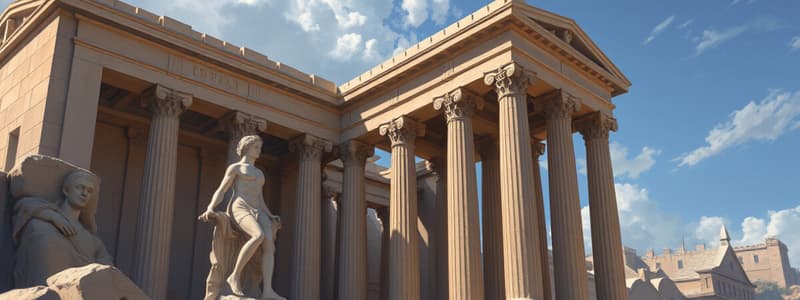Podcast
Questions and Answers
What period does the High Classical refer to?
What period does the High Classical refer to?
- 500 BCE - 450 BCE
- 350 BCE - 300 BCE
- 400 BCE - 350 BCE
- 450 BCE - 400 BCE (correct)
Who designed the Parthenon?
Who designed the Parthenon?
Iktinos and Kallikrates
The Temple of Athena Nike was built to commemorate the victory over the Persians.
The Temple of Athena Nike was built to commemorate the victory over the Persians.
True (A)
The statue of ____ Parthenos was located in the cella of the Parthenon.
The statue of ____ Parthenos was located in the cella of the Parthenon.
What is the primary material used in the construction of the Parthenon?
What is the primary material used in the construction of the Parthenon?
What sculptural technique is emphasized in the 'Nike Adjusting her Sandal' statue?
What sculptural technique is emphasized in the 'Nike Adjusting her Sandal' statue?
Which sculptor created the 'Doryphoros'?
Which sculptor created the 'Doryphoros'?
The Erechtheion housed a statue of Athena's wooden statue for the Panathenaic festival.
The Erechtheion housed a statue of Athena's wooden statue for the Panathenaic festival.
Match the following figures with their descriptions:
Match the following figures with their descriptions:
What innovation in sculpting is Polykleitos known for?
What innovation in sculpting is Polykleitos known for?
The _____ of Athena Nike was designed as a reference to victory over the Persians.
The _____ of Athena Nike was designed as a reference to victory over the Persians.
Flashcards are hidden until you start studying
Study Notes
High Classical Period
- Timeframe: 450-400 BCE; era highlighted by the defeat of Persians and the peak of Greek civilization.
- Notable advancements in sculpture and architecture; anatomy and drapery detail became more refined.
- Polykleitos established a canon of proportions for ideal sculpture; Iktinos and Kallikrates utilized mathematical principles for temple design, believing beauty stems from harmonic numbers.
Doryphoros (Spear-Bearer)
- Sculpted by Polykleitos, represents the ideal male figure and embodies classical artistic principles.
- Incorporates contrapposto and a system of balanced proportions for realistic movement.
Parthenon
- Designed by Iktinos and Kallikrates; made of marble representing peak architectural achievement.
- Features a Doric temple style, dedicated to Athena Parthenos; underwent several changes over time.
- Notably irregular shape despite mathematical precision; utilizes architectural contrapposto to enhance visual depth.
Athena Parthenos
- Massive statue located in the Parthenon's cella; stands at 38 feet tall, composed of gold and ivory.
- Depicts Athena fully armed, holding a representation of Nike; symbolizes victory and the triumph of civilization over chaos.
- Statue's materials were later melted down, reflecting the transient nature of such works.
Temple of Athena Nike
- Constructed between 427-424 BCE, designed by Kallikrates in an Ionic style.
- Celebrates victory over Persians, adorned with multiple images of Nike, often linked to rituals and trophy-display.
Nike Adjusting Her Sandal
- Sculpted relief within the Temple of Athena Nike; showcases almost transparent garments and delicate depiction of the female form.
- Highlights the interplay of flowing material and body outline, exemplifying high classical stylistic features.
Grave Stele of Hegeso
- Created around 400 BCE, attributed to Kallimachos; a relief piece marking Hegeso's tomb.
- Illustrates a serene moment between a mistress and servant, reflecting societal roles of women in domestic vs. public spheres.
- Represents patriarchal themes in art and serves as an enduring grave marker.
Plaque of Ergastines
- Dates between 447-410 BCE; artifact by Iktinos and Kallikrates with hierarchical relief work.
- Depicts six Ergastines in a religious procession, celebrating both the deities and Athenian civic life.
Diskobolos (Discus Thrower)
- Sculpted around 450 BCE, represents dynamic movement captured in a discus throw; notable for its vigorous action.
- Artist achieves interest through the creation of dynamic arcs in the athlete's pose.
Riace Warrior
- Bronze statue from around 450 BCE, features intricate details such as embedded eyes and copper accents.
- Employs contrapposto to convey natural motion; hollow-casting technique used due to the cost and impracticality of solid bronze.
Pericles
- A prominent figure around 429 BCE known for contributing to an idealized representation of man; emphasized noble appearance in art.
Erechtheion
- Marks the significance of Athena's victory over Poseidon; housed a wooden statue of Athena for its festivals.
- Characterized by Ionic design with Caryatids substituting traditional columns, showcasing unique architectural innovation.
Propylaia
- Built between 437-423 BCE; serves as a grand entrance to the Acropolis.
- Combines Doric and Ionic elements, illustrating the complexity of Classical architecture in monumental forms.
Studying That Suits You
Use AI to generate personalized quizzes and flashcards to suit your learning preferences.




